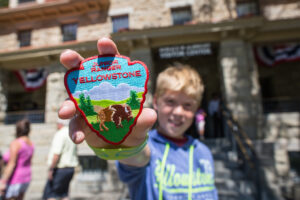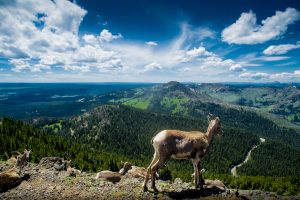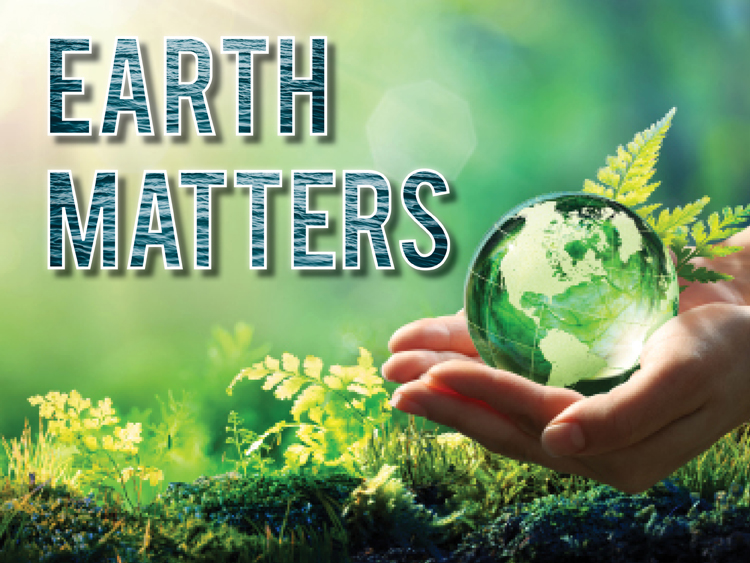Why is it Worth Checking this Place Out?
 The impact Yellowstone’s geology has had on the region, continent, and world for millions of years cannot be overstated. Yellowstone’s breathtaking beauty exists between pairs of opposites: extreme heat and cold, solid rock and flowing water, explosive life and tragic death, searing sun and frigid night sky. The elemental forces of this area cycle between gentle heat that gives vital energy for wildlife to thrive, and massive, violent, explosive destruction that has the ability to alter the weather of the entire planet. What we know and appreciate about Yellowstone pales in comparison to the volumes and layers we have yet to learn. Dip your toe into the geothermal pool and discover how this amazing place compelled the world to first consider conserving land for its own sake and beauty.
The impact Yellowstone’s geology has had on the region, continent, and world for millions of years cannot be overstated. Yellowstone’s breathtaking beauty exists between pairs of opposites: extreme heat and cold, solid rock and flowing water, explosive life and tragic death, searing sun and frigid night sky. The elemental forces of this area cycle between gentle heat that gives vital energy for wildlife to thrive, and massive, violent, explosive destruction that has the ability to alter the weather of the entire planet. What we know and appreciate about Yellowstone pales in comparison to the volumes and layers we have yet to learn. Dip your toe into the geothermal pool and discover how this amazing place compelled the world to first consider conserving land for its own sake and beauty.
The Early Years of Yellowstone
Way back in 1863, the area around Yellowstone became an incredibly popular spot for prospectors looking to strike it rich during the gold rush. The clue that attracted the attention of those in search of gold was the brightly colored yellow and red stains found on rocks all over the region. This is a sign that hot water is moving and concentrating heavy elements like lead, mercury, gold, and silver.
Yellowstone became the world’s first national park on March 1, 1872 when President Ulysses S. Grant designated it as such, and appointed Geologist Ferdinand Hayden as the first director of the park. The Yellowstone National Park Protection Act designated the original 1.7 million acres, which included parts of Idaho, Wyoming, and Montana, as a protected zone that would “provide for the preservation, from injury or spoliation, of all timber, mineral deposits, natural curiosities, or wonders within said park, and their retention in their natural condition.” This means that the park is one of the very first land conservation efforts in the world. This act sparked a change in public thinking that spurred new land and species conservation acts worldwide.
Ways to Explore Yellowstone and its Hidden Science:
Iconic Spots
With so many different aspects of Yellowstone to explore, we suggest you start by getting an idea of the true scope and scale of this incredible park. Google Earth has you covered with a virtual visit to all of the most iconic spots in the park.
The Yellowstone Super Volcano System
The geology of the area has created all the formations we will explore on our field trip today. Check out this episode of PBS Eons that explains all about this massive geologic feature and how it shapes our understanding of the past.
Discover Yellowstone’s Extreme Life
Yellowstone is home to incredible microorganisms called thermophiles that are able to live in some of the hottest environments on earth. The growth of these thermophiles are what create some of the beautiful colors in iconic Yellowstone spots.
Explore aspects of the park from your couch and become a Junior Ranger.

Conservation and Sustainable Park Visits
 Conservation of natural spaces, ecosystems, and the protection of the almost 400 different species of wildlife is at the heart of the mission of Yellowstone National Park. Check out the links below to learn more about the animals that call Yellowstone home and the ways they are being protected.
Conservation of natural spaces, ecosystems, and the protection of the almost 400 different species of wildlife is at the heart of the mission of Yellowstone National Park. Check out the links below to learn more about the animals that call Yellowstone home and the ways they are being protected.
Current Science
Telemetry the Yellowstone Science Podcast
Explore Yellowstone through pop culture!
Yellowstone was the inspiration for Jellystone Park where Yogi Bear and his picnic basket-stealing partner Boo-Boo lived.
As You Explore, Think About These Questions:
When scientists study places like Yellowstone, they search for patterns to try to understand why and how things are changing. They also look deeper into those changes to try to determine what causes them, and the effect those changes have on other aspects of the environment. Yellowstone is full of little and big changes that can alter the stability of this complex ecosystem. As you explore, put on your geologist/conservationist hat and see if you can discover the answers to some of these questions. Now you’re thinking like a scientist!
- How does heat make this area unique?
- What role does water play in the park and surrounding area?
- In what ways do humans and animals interact in and around the park, and how have those interactions changed over time?
- What changes are scientists studying at Yellowstone? Why is it important to monitor what is happening there?
A Model Park for The World
Since its inception, Yellowstone has grown to over 2.2 million acres (which is about three times the size of Rhode Island), and sees more than 3 million visitors annually. This poses a unique set of challenges for the park managers. Balancing the influx of visitors who are curious to see incredible natural wonders and maintaining the integrity of the park are sometimes at odds. Visitors who explore the park in person can help to protect it by following the National Park Service’s one simple rule: “Leave No Trace.” Respect the wildlife and park resources, leave only footprints, and take only pictures.
The ideas first proposed by conservationists in the 1800’s gave way to what writer and historian Wallace Stegner called “America’s best idea” – a revolution that not only saw the creation of Yellowstone, but also the designation of 57 additional national parks within the United States and over 4,000 national parks around the world, ensuring that beautiful places will exist for generations to come.
Stay connected! Be sure to subscribe to Down to a Science— The Official Blog of the Connecticut Science Center and follow us on social media.

Bryan Avery has been working as a STEM Educator at the Connecticut Science Center for 3 years. He develops and facilitates student programming in our labs as well as traveling programs. He holds degrees in Geology and Parks and Natural Resource Management from Hartwick College and Slippery Rock University. Creating exciting new ways for students to interact and engage with STEM is his professional passion. He has a flare for delivering shows to crowds as well as working one-on-one where he pushes students to think deeper and make connections between STEM, their lives, and their community. On his time off, he enjoys playing disc golf, guitar, and being outdoors.




